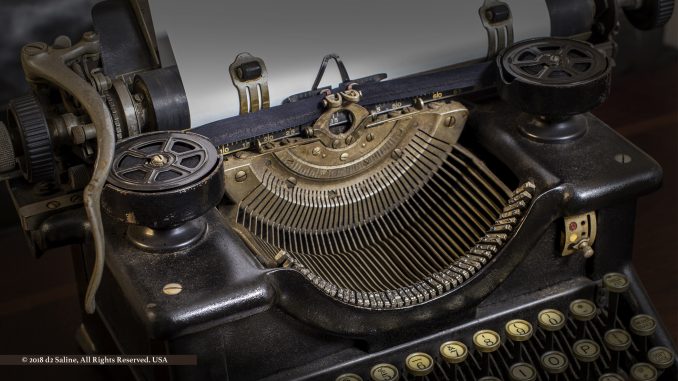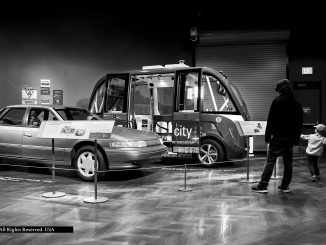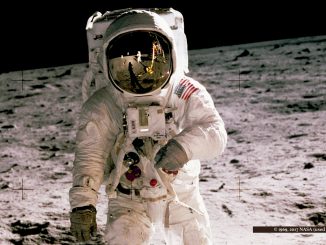
From the Editor—
This past Saturday, I spent a couple of hours at the Saline History Museum. No “Independence Day” event, as that had been cancelled late on Thursday prior due to extreme heat forecasts. Notwithstanding, the museum was still open per weekly routine. [1]
Visitor numbers appeared to be up a bit, at the caboose, shed, and inside the depot itself. At one point I spent quite a while sitting down with Bob Lane inside the station agent’s office, talking cemeteries and Summerfest. That’s when one man in particular came down from the display area with his family, evidently quite pleased with what he and his group had seen.
Noting that access was free (as always), he asked how he might make a donation. Mr Lane kindly directed the visitor to a large metal container that the fellow had just passed. It was painted white, repurposed, located next to the stair landing now behind the inquiring father.
That exchange reminded me of a conversation I’d had last November with Noel Poirier, Director of the National Watch & Clock Museum. “Always have people exit through the gift shop,” he advised. “That’s ‘Museum Layout 101.’ Make it as easy as possible for people to support what you’re doing for them. Ask.” [2]
I saw a great example of this at the Detroit Institute of Arts a couple of weeks ago when photographing their special “Star Wars” exhibit. I’d been given special access to do my work there, given restrictions on those permitted to use professional gear. Still, I wasn’t getting out until I’d passed through a gift shop that was itself as varied in product and appealing in presentation as any gallery set out prior in the route. [3]
And then there was Dr John Charpie. During my interview with him as co-director of the CS Mott Congenital Heart Center, he provided detailed information on their appeal for donations. At first I must confess to having felt a bit put off. This is a news article, not an advertisement, I thought in one of the more rigid parts of my brain. [4]
Then I realized that this was part of the objective journalism. The direct, bold ask was key to understanding the subject at hand. How else could Dr Charpie’s program have gotten to where it is?
Closer to home, Saline Area Social Service (SASS) Executive Director Jamail Aikens is a signature example. A handful of years ago, Food Gatherers was the stock source for SASS. Under Mr Aikens’ leadership, that has changed significantly; the mission of his organization is now largely supported by a larger variety of other businesses that reliably provide what his constituents need. How did he accomplish this change? [5,6]
“I ask and I ask and I ask,” he told me with a sincere smile.
Attend many Saline City Council meetings and you might be inclined to think that “asking” is easy, that everyone is doing it. It happens all the time.
Saline Main Street appears particularly adept at making its needs for financial support known. Chambers was packed with advocates each time the Non-Discrimiation Ordinance was debated. The Carpenter family literally came bouncing into the room to discusss their proposal for a new Knockerball franchise placement in the old Blockbuster Video space. And just two weeks ago, changes to longstanding rules regarding liability for damaged to headstones were approved unanimously — because one individual had effectively spoken up for it. [7,8,9,10]
Unfortunately, this approach isn’t used by all.
Last year marked the thirty-fifth event for the Saline Street Machines car show. Let that sink in: Thirty-five years. The night before that show, I was uptown speaking with organizer Larry Weber and he told me that the time was rapidly approaching when he’d have to step away from his role with this. Without succession, the show would end that year or this. [11]
That was the first I’d heard any of that, and I’ve shown cars with them for years. I’m willing to bet this has been recent news to many Saline Journal readers as well.
Our Saline Area Historical Society is almost as old, marking its thirtieth year in 2017. I can guarantee that their resource needs don’t end with the replaced belfry, as Jim Peters emphasized last week.
Looking through some of our old accounting ledgers in April, I came across an entry for D² Enterprises membership from 1988. We never stepped up for a brick paver of foundation block, but we did work with our first landlord on Monroe Street in making a purchase. I’m confident the Society would still let us buy one today, should we choose to ask. [12,13]
It would be great if more people asked, too, in more places, more often.
But the biggest impact has to come from the organizations themselves. Ask. Tell everyone you encounter of your needs, the importance of your mission, the value that you all deliver. Look for ways to persuasively, repeatedly state your case. Place donation containers square in the middle of aisleways, en route to exits through your gift shops.
References
- “Saline Depot Museum” Saline Area Historical Society.
- National Watch & Clock Museum (home page).
- “Star Wars and the Power of Costume” Detroit Institute of Arts.
- “Exclusive Interview with Dr John Charpie on UofM CS Mott Congenital Heart Center LPGA Volvik Pro-Am” Dell Deaton (May 14, 2018) Saline Journal.
- Saline Area Social Service (home page).
- Food Gatherers (home page).
- “Document Center” Saline City Michigan.
- Saline Main Street (home page).
- “New Non-Discrimination Ordinance Can Further Enhance the Value of Saline” Dell Deaton (April 3, 2018) Saline Journal.
- Knockerball Michigan (home page).
- “Saline Street Machines Car Show Marks 35th Year (with Local Videos)” Dell Deaton (August 15, 2018) Saline Journal.
- “How Well Do You Know the Community Impact of Your Saline Area Historical Society?” Dell Deaton (April 19, 2018) Saline Journal.
- “Fifteen Months Ago, The Rentschler Farmhouse Bell Went Silent With A Deafening Bang; Today It Properly Rings Again” Dell Deaton (June 29, 2018) Saline Journal.



